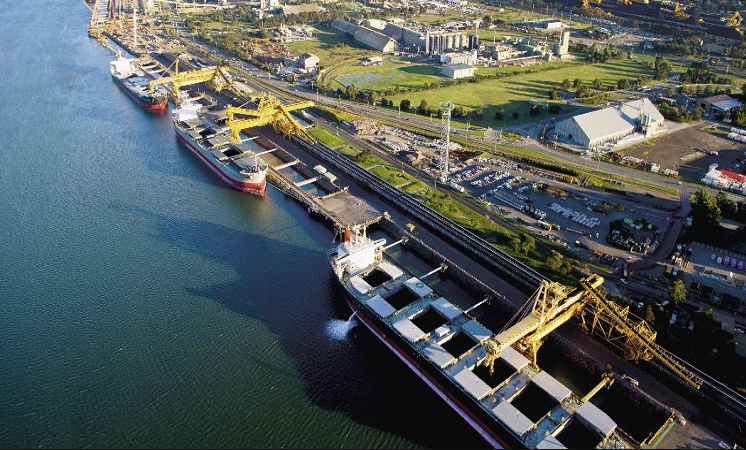Daily Coal Prices
- Premium Low Vol (FOB Australia) $252/mt (-10.00)
- CFR China PLV equivalent (Mar ’23) $276.00 (-4.00)
- PCI (FOB Australia) ~$153 (unch)
- Semi-Soft (FOB Australia) $146 (-3.00)
- Low Vol HCC (USEC) $225 (unch)
- High-Vol A (USEC) $218 (unch)
- High-Vol B (USEC) $193 (unch)
- FOB Newcastle (6,000) (Mar ’23) $128.90 (-0.50)
- FOB Newcastle 20% Ash (5,500) $93 (unch)
- CFR India West (5,500) $114 (-4.00)
- Kalimantan (4,200) $58 (unch)
- CIF ARA (6,000) (Mar ’23) $111.75 (-1.20)
- Richards Bay (5,500) $82 (unch)
- Baltimore 3% Sulfur (6,000) $72 (unch)
Coking Coal Prices Finally Bottom?
Premium PLV Hard Coking Coal benchmark prices were down $4.50/mt to $246.75/mt on Thursday, March 21, 2024. Spot assessments continue to chase the SGX April contract prices lower. April’s contracts are currently priced at $246/mt, so most of the selloff is probably over for now. Meanwhile, the forward curve has improved, with December 2025’s contract now priced at $269/mt on the SGX. The Coal Trader’s Read – I think the bottom is in for now. Moreover, the tail-end of the forward curve actually moved up overnight, suggesting any short-term supply rationalization could lead to further supply shortages in the future.
Thermal Coal News
Bearish: Pacific Basin coal prices fell 6% to a one-month low due to oversupply despite strong demand from China. Global Coal’s Newcastle index dropped to $125.01/t, the lowest since February 26. Weak demand in Europe and China pressures prices, although China’s power shortages sustain import demand. Chinese thermal coal imports may reach 31.1m tonnes in March. Rising coal stocks at Chinese ports indicate a well-supplied market. Bearish gas market further dampens coal prices. Asia’s JKM LNG contract settles lower. The Coal Trader’s Read – I’m pretty bearish on natural gas/LNG prices at the moment, which would imply lower thermal coal prices globally. More Here
On March 19, globalCOAL managed 3 contracts in Australia’s thermal coal market. Each contract involves the delivery of 25,000 tons of Australian thermal coal (Phys NEWC, FOB Newcastle) in April and May. Prices ranged from US$123.00 to US$124.50, as outlined in the attached table.
China’s thermal coal market sees domestic preference as import prices lose appeal. With thermal coal prices declining at northern ports for three weeks, domestic coal becomes more competitive. Import prices rose due to global supply concerns while domestic demand remained weak. Some coastal power plants switch back to domestic coal. This trend may stabilize domestic prices briefly, but analysts warn of limited support. Chinese power groups aim to lower settlement prices amid reduced coal consumption. Overall, limited demand suggests continued price competition. More Here
Coal prices in major production areas of China remain weak, particularly for lump coal, with sales declining notably. The market is cautious, with traders and terminals reducing purchases and lowering prices. Despite slight improvements in shipments for some high-performance coal mines, overall sales remain poor. With high inventory pressure, prices continue to decrease. Concerns arise as thermal coal prices at ports fall, but experts doubt it will dip below last year’s low. Limited supply increment and uncertain demand contribute to market instability. The Coal Trader’s Read – sounds like a short-term oversupply situation in China as stockpiles are high and cold winter weather turns towards the spring.
In February 2024, China’s thermal coal imports surged by 21.38% year-on-year, totaling 25.007 million tons. However, there was a month-on-month decline of 16.33%. The import value reached $2.008 billion, dropping by 8.59% year-on-year. From January to February, thermal coal imports rose by 23.35%, reaching 54.894 million tons. Lignite imports in February amounted to 12.438 million tons, with a year-on-year decrease of 2.09%. The Coal Trader’s Read – seaborne thermal market feels overdone at this point as Spring weather approaches and inventories remain healthy.
India’s Russian coal imports decreased by 26.6% from August to December 2023, totaling 8.226 million tons. Metallurgical coal increased by 6.4%, while thermal coal dropped by 37.6%. Conversely, US coal imports surged by 38.7%, totaling 22.497 million tons, with metallurgical coal up 42.6% and thermal coal up 80.4%. India aims to boost thermal coal production to meet rising power demand.
Sunrise Coal, Indiana’s second-largest coal producer, will lay off 112 workers across its Freelandville, Oaktown, and Prosperity sites starting April 23. The Coal Trader’s Read – I discussed how Hallador Energy (HNRG) was a short on Twitter (X) a month ago, or so. I never pulled the trigger due to the unknowns around their power plant ownership being tough to model. Either way, any landlocked thermal coal producer in the US is in big trouble, in my view. Hallador definitely fits that category. More Here
Donkin coal mine in Cape Breton, Canada, shut down since July due to roof falls, now permitted to resume year-round production. Nova Scotia Labour Department lifts stop-work order after a third-party review of humidity management plan. Geological expert highlights seasonal roof stability challenges. Kameron Coal may reopen if it chooses, pending safety compliance. Inspectors promise rigorous oversight. The mine, the world’s only subsea coal mine, faced closures due to safety violations and price slumps. The Coal Trader’s Read – I did a long write-up on the Donkin Mine and Morien Resources, see here. More Here
Chinese imports of Russian coal dropped in the first two months of the year due to reinstated import taxes, making Russian coal less competitive. China’s total coal imports rose by 23%, but Russian sales fell by 22%. Tariffs, reinstated in January, affect Russian imports while exempting others like Indonesia and Australia. Policy shift aims to protect Chinese miners from oversupply. US sanctions on Russian coal exporters further dampen Chinese interest. Analysts predict continued uncertainty in Russian coal imports due to political tensions. The Coal Trader’s Read – this is bullish for thermal coal and probably semi-soft and PCI as well, if the trend continues. More Here
Yunnan province is conducting safety evaluations for 60 coal mines post-holiday. These mines must resume operations by the end of March. The examination focuses on safety management, geological support, ventilation, gas control, fire prevention, and machinery. The notice emphasizes rectifying issues promptly. The Yunnan Bureau of Mine Safety has already evaluated four mines and ordered two to undergo further assessments. Numerous coal mines are listed for examination, covering various regions across the province. The Coal Trader’s Read – the re-energized focus on safety may lead to coal production cuts across China, which would be bullish.
A gas explosion at a coalpit in Balochistan, Pakistan, killed 12 miners and trapped eight others, who were later rescued. Director-General of Mining Abdullah Shahwani confirmed the incident, attributing it to methane gas. Prime Minister Shehbaz Sharif expressed condolences. Deadly accidents are common due to poor safety standards. In 2018, 23 died in similar explosions, and in 2011, 43 perished in another incident. Lala Sultan of the Balochistan Coal Mines Workers Federation criticized safety negligence in the region. More Here
Metallurgical Coal News
Bearish: Australian coking coal prices fell $10/t to $252/t on March 20, 2024, due to weak global steel demand, marking a 25% decline in March. Oversupply in spot markets, driven by subdued demand in India and China, led to decreased prices. China’s declining coking coal and coke production adds to the oversupply. Indian steelmakers adopt a cautious approach ahead of elections. Expectations of further price declines deter immediate buying. Reduced demand from major importers shapes market dynamics, with China’s economic slowdown also impacting coking coal demand. More Here
Bearish: Australian coking coal prices dropped 11.7% to $270.9/t in March. Chinese CFR price stood at $287/t. Singapore Exchange saw April futures at $254/t. Macquarie forecasts hard coking coal at $300/t by year-end due to increased supply. Chinese market subdued with potential production cuts. India awaits price decline before buying. Mine emergencies and reduced real estate demand affect producers. Delays in U.S. supply boosted Australian prices earlier but weakened afterward due to lower demand. The Coal Trader’s Read – this article’s price data is a couple days old, but you may find the narrative interesting. More Here
Bullish: In February, China’s coking coal imports rose by 13.8% year-on-year to 7.87 million tons, while anthracite coal imports fell by 47.3%. The total value of coking coal imports amounted to US$1.39 billion, with an average price of US$176.1/ton. From January to February 2024, coking coal imports reached 17.890 million tons, a year-on-year increase of 36.5%, valued at US$3.13 billion, up 21.6% compared to the same period last year. The Coal Trader’s Read – despite price weakness in Chinese coking coal markets, the continued demand for imports suggests the supply rationalization we’ve heard about, whether due to safety or geology, is real.
Australian coal producers seek private loans amid ESG concerns hampering bank lending. Whitehaven Coal’s $1.1 billion loan attracted 17 private lenders and one bank. Golden Energy seeks similar financing. Private credit firms’ interest signals a shift in coal financing. Banks’ retreat prompts alternative funding sources like private equity and asset-backed bonds. Whitehaven’s loan, mainly from international funds, illustrates higher borrowing costs. Private credit assists coal miners transitioning to metallurgical coal. ESG concerns drive mainstream lenders away from coal financing. More Here
Arch Resources, a US company, appointed George J. Schuller Jr. as Senior Vice President and Chief Operating Officer, effective immediately. Previously, Schuller Jr. served as Chief Operations Officer at Compass Minerals since 2019, and held senior operational roles at Peabody Energy, including positions in Australia and as Group Executive of Powder River Basin.
Power, Energy & Carbon Market News
Bullish: Shanxi Province has 6 coal power projects under construction and 6 planned projects. After the “14th Five-Year Plan,” some outdated units will be closed, increasing installed capacity by 15 million kilowatts. Efforts align with national directives for coal power development, emphasizing safety and quality. Central enterprises are expected to lead in ensuring timely production. Power grid supervision ensures projects connect on schedule, enhancing power supply reliability. The Shanxi Energy Supervision Office commits to ongoing oversight and reporting. The Coal Trader’s Read – Chinese continue developing “clean coal” power plants, which just means “more efficient.”
Xi Jinping chaired a symposium on advancing the central region’s development, emphasizing strengthening coal and fossil energy security. He highlighted the central region’s importance in agriculture, manufacturing, and transportation, urging policies for high-quality development. Priority lies in ensuring food, energy, and resource security. Initiatives include enhancing coal and rare earth utilization and advancing new energy systems, emphasizing traditional-new energy integration. The aim is to bolster basic energy guarantees and accelerate modernization.










